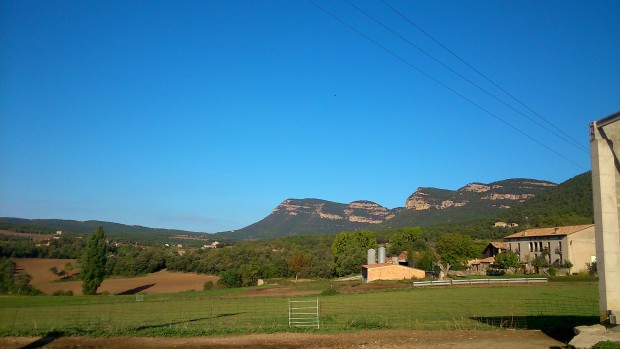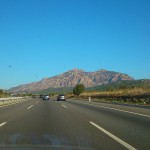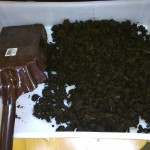- Sieving the soil
- Handling manure (fancy word for poop…)
On Monday morning, Joan and I headed out of Barcelona to collect soil and manure for my lab incubation experiment. We had designed an experiment where we would add different stabilized organic matter amendments to soil: biochar (very stable), compost (semi-stable), fresh manure (labile, that is, easily decomposed). We would then examine how quickly decomposition occurred in the soil. To begin, we needed to gather the necessary materials. Since we already had biochar and compost, we had to collect the soil from a field and pick up manure from a farm.
First, pick up the manure. We drove for about an hour and a half out of Barcelona, over green, pine-covered mountains, through valleys filled with old towns and factories, past Montserrat with its funicular and ancient monastery. A little before 10am we arrived at the organic farmer/shepherd’s home with whom Joan often collaborates in the town of L’Espanyula. The owner, Josep’s, family has had the farm for generations and after inheriting if from his father, he transformed it into an organic farm. Josep took us to his sheep stables and with a pitchfork filled a large plastic bag with smelly manure for us, under the curious gaze of the sheep who soon went back to chomping on their hay. The surrounding mountains, large country home, and cool, calm morning definitely made a good case for a quiet, country life. As Josep described his ideas for testing and combining different conservation agriculture practices on his farm, you could tell how much passion he has for his livelihood, his animals, and his land.
All set with our stinky load, we headed out over more rolling hills to a field next to a forest in an area with acidic soils, one of the few areas around Barcelona with non-carbonated soils, that is with lower pH. Since we would be measuring the carbon in the soil with our organic amendments, a soil with already high carbon amounts could interfere with the measurements. After another hour of driving, we stopped at the side of a country road and walked up a trail to an open field. With a shovel, we quickly filled a few plastic bags with soil and were soon on our way back to Barcelona.
The rest of the week was spent preparing the soil (crushing clumps and sieving it) and trying to homogenize the manure by removing as much hay as possible and breaking up clumps (don’t worry, I wore gloves). However, on Thursday, in between reading articles and discussing the experimental design with Joan, we thought of going a different path toward isotope tracing. Isotopic tracing is a method that uses isotopes such as C14, C13, N14, or N15 to trace the origin of a substance. Carbon-14 dating, for example, is a common technique used in archaeology to date the age of ancient fossils.
I have not worked with isotopes before so I was excited to be able to learn a new technique. However, this meant we would have to change the experiment we had already planned and see where we could get the isotope analysis done. I sent an email right away to my supervisor, Mark, at UBC asking if we could analyse my samples there and he replied immediately with a Yes! So now we could move forward, but were back to square one, designing my experiment. The second experiment which we will switch to now looks like this: 2 types of biochars mixed with 3 different soils. We will be heading back out to collect soils next Monday. In the end, after playing around with poop for a couple of days, it turns out we will not be needing it after all. Oh well. On to more exciting things: isotopes! Oof, I have a lot of reading to do…



